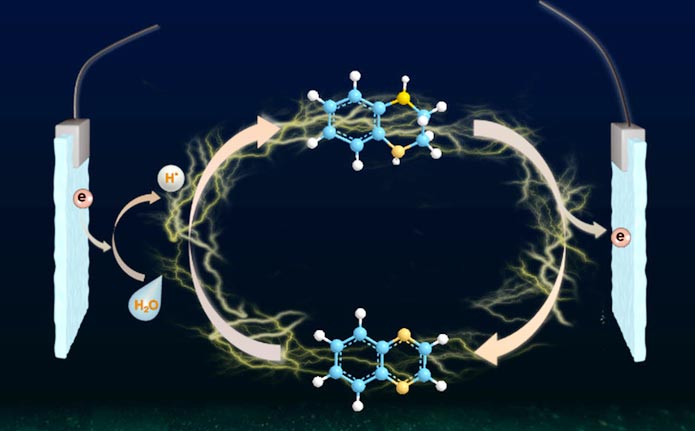Hydro/dehydrogenation of N‐heterocycles over bifunctional MoNi4 electrode with water

A water-involved electrochemical transfer hydrogenation and dehydrogenation of N-heterocycles is developed. Self-supported MoNi4 alloy is designedly synthesized as the bifunctional electrode enabling both the transfer hydrogenation of unsaturated N-heterocycles using the active hydrogen atom (H*) in situ produced by water electrolysis, and the oxidative dehydrogenation of saturated N-heterocycles using the in situ formed NiIII species.
Credit: Chinese Journal of Catalysis
A novel electrochemical strategy for efficient hydrogen storage.
The catalytic hydrogenation of N-heteroarenes showcases wide and important applications in the fields of synthetic chemistry, drug discovery, materials science, and hydrogen storage. However, it remains a long-standing scientific and technological challenge in breaking the aromaticity of substrates and overcoming catalyst poisoning by either substrates or hydrogenated products. Although different homogeneous systems mainly based on precious metal catalysts have been developed, harsh conditions with extra additives are always required.
Furthermore, homogeneous catalysis not only requires expensive ligands but also has an inherent limitation in recycling, hindering its large-scale application. In contrast, the heterogeneous systems offer a promising alternative since the catalysts can be easily recovered and reused. However, both homogeneous and heterogeneous catalytic hydrogenation methods generally require flammable and explosive gaseous H2 or other expensive/toxic hydrogen sources, causing severe safety risks and environmental concerns. Furthermore, deuterium labeling plays a vital role in the pharmaceutical industry because of its kinetic isotope effect. N-heterocycles are common structural motifs in alkaloids and bioactive molecules of drugs and agrochemicals. But the reported strategies exhibit low compatibility with the deuterated N-heterocyclic compounds owing to the hard access to suitable deuterium sources. Thus, developing a facile and sustainable hydrogenation (deuteration) strategy of N-heteroarenes over low-cost non-noble metal catalysts with cheap and safe hydrogen (deuterium) sources is highly desirable.
Aqueous electrocatalytic hydrogenation (ECH) is emerging as a promising and sustainable approach for reducing multifunctional chemicals, such as CO2, NO3–, and biomass. Unlike the traditional methods, aqueous ECH uses the electrochemically in situ generated active hydrogen atom (H*) on the electrode surface by proton reduction or water splitting for the synthesis of hydrogenated products. It avoids the use of high pressure and flammable H2 and other expensive and toxic hydrogen donors, demonstrating good economy and sustainability. In this regard, electrochemical transfer hydrogenation is highly recommended as an appealing strategy for the hydrogenation of organic compounds. Currently, the most studied cases of organic ECH are focused on the reduction of carbonyl and nitro groups. However, those highly conjugated and stable arenes are rarely touched, and still remains a challenging task. Accordingly, it is significant to achieve ECH of N-heteroarenes by exploiting appropriate cathode material for efficiently generating H* and adjusting the adsorption and desorption process of organic molecules on the electrode surface.
Recently, a research team led by Prof. Bin Zhang from Tianjin University, China reported a room-temperature electrochemical strategy for hydrogenation (deuteration) and reverse dehydrogenation of N-heterocycles over a bifunctional MoNi4 electrode, which includes the hydrogenation of quinoxaline using H2O as the hydrogen source with 80% Faradaic efficiency and the reverse dehydrogenation of hydrogen-rich 1,2,3,4-tetrahydroquinoxaline with both up to 99% yields and selectivity. The in situ generated active hydrogen atom (H*) might be involved in the hydrogenation of quinoxaline, and a consecutive hydrogen radical coupled electron transfer pathway is proposed. Notably, the MoNi4 alloy exhibits efficient quinoxaline hydrogenation at only 50 mV overpotential owing to its superior water dissociation performance to provide H* in alkaline media. In situ Raman tests indicate that the NiII/NiIII redox can promote the dehydrogenation process, representing a promising anodic alternative to low-value oxygen evolution. Impressively, electrocatalytic deuteration is easily implemented with up to 99% deuterated ratios by using D2O. This method is capable of producing a series of functionalized hydrogenated and deuterated quinoxalines. The results were published in the Chinese Journal of Catalysis (https://doi.org/10.1016/S1872-2067(21)63834-2).
About the Journal
Chinese Journal of Catalysis is co-sponsored by Dalian Institute of Chemical Physics, Chinese Academy of Sciences and Chinese Chemical Society, and it is currently published by Elsevier group. This monthly journal publishes in English timely contributions of original and rigorously reviewed manuscripts covering all areas of catalysis. The journal publishes Reviews, Accounts, Communications, Articles, Highlights, Perspectives, and Viewpoints of highly scientific values that help understanding and defining of new concepts in both fundamental issues and practical applications of catalysis. Chinese Journal of Catalysis ranks among the top six journals in Applied Chemistry with a current SCI impact factor of 8.271. The Editors-in-Chief are Profs. Can Li and Tao Zhang.
At Elsevier http://www.journals.elsevier.com/chinese-journal-of-catalysis
Manuscript submission https://mc03.manuscriptcentral.com/cjcatal
Media Contact
Fan He
Dalian Institute of Chemical Physics, Chinese Academy Sciences
hef197@dicp.ac.cn
Office: 86-411-843-79240
All latest news from the category: Life Sciences and Chemistry
Articles and reports from the Life Sciences and chemistry area deal with applied and basic research into modern biology, chemistry and human medicine.
Valuable information can be found on a range of life sciences fields including bacteriology, biochemistry, bionics, bioinformatics, biophysics, biotechnology, genetics, geobotany, human biology, marine biology, microbiology, molecular biology, cellular biology, zoology, bioinorganic chemistry, microchemistry and environmental chemistry.
Newest articles

Innovative 3D printed scaffolds offer new hope for bone healing
Researchers at the Institute for Bioengineering of Catalonia have developed novel 3D printed PLA-CaP scaffolds that promote blood vessel formation, ensuring better healing and regeneration of bone tissue. Bone is…

The surprising role of gut infection in Alzheimer’s disease
ASU- and Banner Alzheimer’s Institute-led study implicates link between a common virus and the disease, which travels from the gut to the brain and may be a target for antiviral…

Molecular gardening: New enzymes discovered for protein modification pruning
How deubiquitinases USP53 and USP54 cleave long polyubiquitin chains and how the former is linked to liver disease in children. Deubiquitinases (DUBs) are enzymes used by cells to trim protein…



